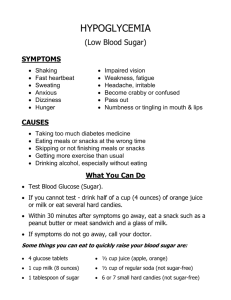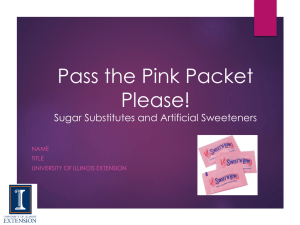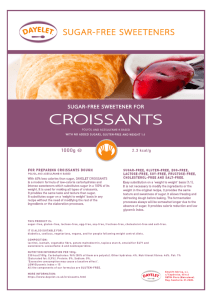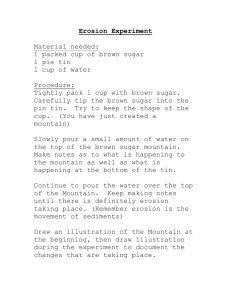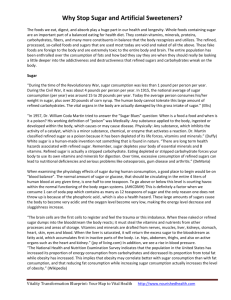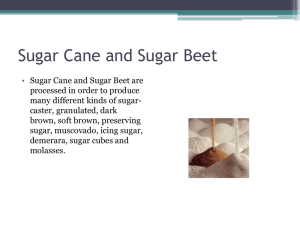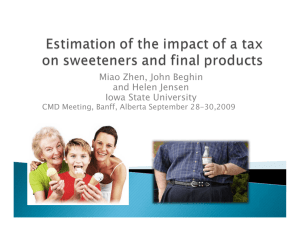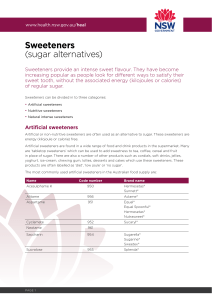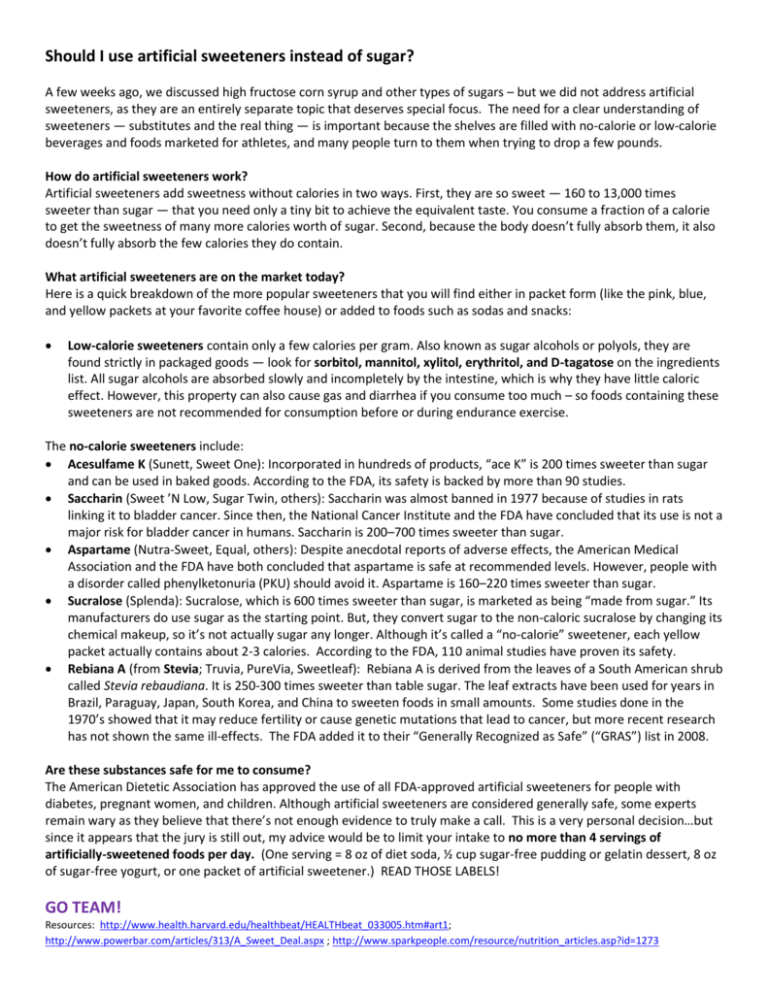
Should I use artificial sweeteners instead of sugar?
A few weeks ago, we discussed high fructose corn syrup and other types of sugars – but we did not address artificial
sweeteners, as they are an entirely separate topic that deserves special focus. The need for a clear understanding of
sweeteners — substitutes and the real thing — is important because the shelves are filled with no-calorie or low-calorie
beverages and foods marketed for athletes, and many people turn to them when trying to drop a few pounds.
How do artificial sweeteners work?
Artificial sweeteners add sweetness without calories in two ways. First, they are so sweet — 160 to 13,000 times
sweeter than sugar — that you need only a tiny bit to achieve the equivalent taste. You consume a fraction of a calorie
to get the sweetness of many more calories worth of sugar. Second, because the body doesn’t fully absorb them, it also
doesn’t fully absorb the few calories they do contain.
What artificial sweeteners are on the market today?
Here is a quick breakdown of the more popular sweeteners that you will find either in packet form (like the pink, blue,
and yellow packets at your favorite coffee house) or added to foods such as sodas and snacks:
Low-calorie sweeteners contain only a few calories per gram. Also known as sugar alcohols or polyols, they are
found strictly in packaged goods — look for sorbitol, mannitol, xylitol, erythritol, and D-tagatose on the ingredients
list. All sugar alcohols are absorbed slowly and incompletely by the intestine, which is why they have little caloric
effect. However, this property can also cause gas and diarrhea if you consume too much – so foods containing these
sweeteners are not recommended for consumption before or during endurance exercise.
The no-calorie sweeteners include:
Acesulfame K (Sunett, Sweet One): Incorporated in hundreds of products, “ace K” is 200 times sweeter than sugar
and can be used in baked goods. According to the FDA, its safety is backed by more than 90 studies.
Saccharin (Sweet ’N Low, Sugar Twin, others): Saccharin was almost banned in 1977 because of studies in rats
linking it to bladder cancer. Since then, the National Cancer Institute and the FDA have concluded that its use is not a
major risk for bladder cancer in humans. Saccharin is 200–700 times sweeter than sugar.
Aspartame (Nutra-Sweet, Equal, others): Despite anecdotal reports of adverse effects, the American Medical
Association and the FDA have both concluded that aspartame is safe at recommended levels. However, people with
a disorder called phenylketonuria (PKU) should avoid it. Aspartame is 160–220 times sweeter than sugar.
Sucralose (Splenda): Sucralose, which is 600 times sweeter than sugar, is marketed as being “made from sugar.” Its
manufacturers do use sugar as the starting point. But, they convert sugar to the non-caloric sucralose by changing its
chemical makeup, so it’s not actually sugar any longer. Although it’s called a “no-calorie” sweetener, each yellow
packet actually contains about 2-3 calories. According to the FDA, 110 animal studies have proven its safety.
Rebiana A (from Stevia; Truvia, PureVia, Sweetleaf): Rebiana A is derived from the leaves of a South American shrub
called Stevia rebaudiana. It is 250-300 times sweeter than table sugar. The leaf extracts have been used for years in
Brazil, Paraguay, Japan, South Korea, and China to sweeten foods in small amounts. Some studies done in the
1970’s showed that it may reduce fertility or cause genetic mutations that lead to cancer, but more recent research
has not shown the same ill-effects. The FDA added it to their “Generally Recognized as Safe” (“GRAS”) list in 2008.
Are these substances safe for me to consume?
The American Dietetic Association has approved the use of all FDA-approved artificial sweeteners for people with
diabetes, pregnant women, and children. Although artificial sweeteners are considered generally safe, some experts
remain wary as they believe that there’s not enough evidence to truly make a call. This is a very personal decision…but
since it appears that the jury is still out, my advice would be to limit your intake to no more than 4 servings of
artificially-sweetened foods per day. (One serving = 8 oz of diet soda, ½ cup sugar-free pudding or gelatin dessert, 8 oz
of sugar-free yogurt, or one packet of artificial sweetener.) READ THOSE LABELS!
GO TEAM!
Resources: http://www.health.harvard.edu/healthbeat/HEALTHbeat_033005.htm#art1;
http://www.powerbar.com/articles/313/A_Sweet_Deal.aspx ; http://www.sparkpeople.com/resource/nutrition_articles.asp?id=1273
Recipe of the Week: Oat Bran Muffins
From Cooking Light Magazine
You didn’t actually think I was going to send you a recipe that included artificial sweeteners, did you?
Here is yet another one of my favorite breakfast, pre- or post-workout, or snack recipes – which is sweetened with
good ol’ brown sugar and fruit. These are great with peanut or almond butter, I usually freeze half of my batch so
that I can defrost them as I need (or want) them! They are a great source of complex carbohydrates, whole grains,
and omega-3 fatty acids (from the flaxseeds – be sure to buy pre-ground flaxseed, or use a coffee grinder to grind
them up at home). TIP: You can substitute old fashioned oatmeal that has been pulverized in a food processor or
blender for the oat bran; I’ve also substituted dried cranberries for the raisins. Enjoy!
1 cup all-purpose flour
1 cup whole wheat flour
1 3/4 cups oat bran
3/4 cup packed brown sugar
1/3 cup nonfat dry milk
1/4 cup flaxseed
4 teaspoons ground cinnamon
2 teaspoons baking soda
2 teaspoons baking powder
1/2 teaspoon salt
2 cups shredded carrot
2 cups chopped Granny Smith apple
1 cup raisins
1 cup fat-free milk
1/4 cup canola oil
2 teaspoons vanilla extract
3 large egg whites
1 thin-skinned orange, unpeeled and quartered
Cooking spray
1. Preheat oven to 375°.
2. Lightly spoon flours into dry measuring cups; level with a knife. Combine flours and the next 8 ingredients
(all-purpose flour through salt) in a large bowl, stirring well with a whisk. Stir in carrot, apple, and raisins.
3. Combine milk, oil, vanilla, egg whites, and orange in a blender or food processor; process until smooth.
Make a well in center of flour mixture; add milk mixture; stir just until moist.
4. Spoon 3 tablespoons batter into each of 28 muffin cups coated with cooking spray. Bake in batches for 20
minutes or until muffins are browned and spring back when touched lightly in center. Remove the muffins
from pans immediately, and place on a wire rack.
Yield: 28 muffins (serving size: 1 muffin)
CALORIES 114 (22% from fat); FAT 2.8g (sat 0.3g,mono 1.3g,poly 0.8g); IRON 1.1mg; CHOLESTEROL 0.0mg; CALCIUM
61mg; CARBOHYDRATE 22.6g; SODIUM 188mg; PROTEIN 3.5g; FIBER 3g
Cooking Light, NOVEMBER 2002
Copyright ©2010 Time Inc. Lifestyle Group. All rights reserved

